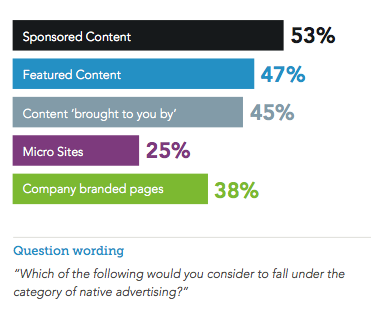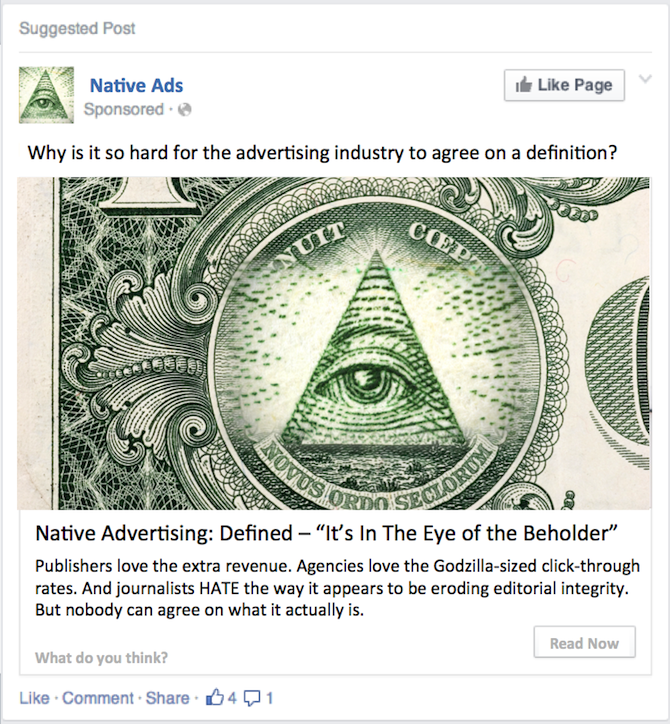It’s one of the most popular (and most polarizing) trends in modern media: “native advertising,” defined in different terms by virtually every person in the industry. Publishers love the extra revenue it generates. Agencies love the Godzilla-sized click-through rates. And journalists HATE the way it appears to be eroding editorial integrity.
But nobody can agree on what it actually is.
After several years in the advertising spotlight, with an estimated $2.4 billion spent on native ads in 2013, there’s still no well-established definition. Even the iab (Interactive Advertising Bureau), specifically tasked with standardizing this sort of thing, still refers to a subcategory of native advertising as “Can’t Be Contained”—meaning ads that are so unique, they’re just flat out impossible to define.
-
“Countless definitions have been proposed by nearly every industry insider, company, and journalist, no universally agreed-upon one has surfaced. This is because, to a large extent, native is in the eye of the beholder, depending on where one sits in the ecosystem and the strategic and media objectives of the marketer.” – iab, Native Advertising Playbook
Related: 9 Native Advertising Best Practices
Native Advertising Defined: Industry Viewpoints
A quick Google search is all it takes to drive home just how little agreement there is out there on how the heck Native Advertising is defined. Here are a few of the more prominent attempts:
iab, Native Advertising Playbook
Native advertising defined as: “Paid ads that are so cohesive with the page content, assimilated into the design, and consistent with the platform behavior that the viewer simply feels that they belong.”
Wikipedia
Native advertising defined as: “An online advertising method in which the advertiser attempts to gain attention by providing content in the context of the user’s experience. Native ad formats match both the form and function of the user experience in which they are placed.”
Mitch Joel, Harvard Business Review
Native advertising defined as: “An ad format that must be created specifically for one media channel in terms of the technical format and the content (both must be native to the channel on which they appear and unable to be used in another context). For example, you can’t place a Google AdWords campaign on The New York Times’ website and you can’t run a promoted tweet on The Huffington Post’s Twitter feed.”
Erin Griffin, Fortune Magazine
Native advertising defined as: “The sort of advertising that looks very much like editorial content but is, in fact, directly paid for by an advertiser.”
Ken Auletta, The New Yorker
Native Advertising Defined as: “Basically, saying to corporations that want to advertise, ‘We will camouflage your ads to make them look like news stories.’”
John Oliver, Last Week Tonight
Native Advertising Defined as: “When a piece of ostensibly normal content is stamped with tiny disclaimers, and then contains messages that are often clear endorsements.”
Sharethrough
Native Advertising Defined as: “A form of paid media where the ad experience follows the natural form and function of the user experience in which it is placed.”
Hexagram’s “State of Native Advertising 2014” report polled advertising professionals—publishers, brands, and agencies—in an attempt to find some sort of agreement on how to define native advertising. The results were less than encouraging, with only one category of ads—sponsored content—being considered “native advertising” by the majority of respondents (and a tiny majority at that: just 53%).

Native Advertising, defined in totally different terms by publishers, brands, and agencies (Image courtesy of Hexagram)
Not surprisingly, a number of the industry professionals that Hexagram polled stated they had no idea what “native advertising” was. And looking over the iab’s “Six Core Types of Native Advertising,” it becomes clear that a lot of publishers are using the term to refer to placements and formats that the industry at large may not agree with. Rather than provide a rigid system for the way native advertising is defined, the iab currently employs an “I know it when I see it” approach. It’s not perfect, but right now it is as close to an industry standard as we have.
In other words, tread carefully. Before you decide to allocate budget to native ads, it’s worth taking the time to make sure you are defining exactly what your money is really buying you.

